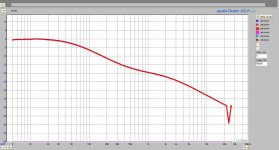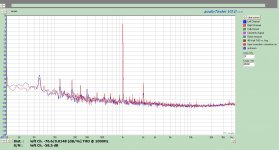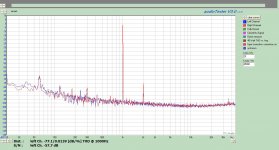Hmm R6 (2nd stage's Rs) is 33R... That Jfet seems isn't 8.8mA IDSS, looks like less. When the buffer's Jfets draw as IDSS stated. Is your R10 6k8? Can you add 1.2k in series with R10? That will give even more gain and it will centre the buffer. Look for 10V on second stage's drain.
Now that they are put there, and there is good channel matching I would prefer more gain with 8k R load total. Now you got more 2SKs from that shop down the road?
I was too quick. Before I saw your reasoning I changed them. I did a quick check on the channels and they still match. See Attached.
The buffer are now sitting at 11.6 on right and 11.4 on Left
Sorry about that, but from my perspective and in hindsight, it it alot easier then redlining all of the schematics🙂. I also would prefer not to have too much more gain. The thing allready blows the windows out.
If I did my math right, I need about 150R now
P.S. guess I should attache the graph
The buffer are now sitting at 11.6 on right and 11.4 on Left
Sorry about that, but from my perspective and in hindsight, it it alot easier then redlining all of the schematics🙂. I also would prefer not to have too much more gain. The thing allready blows the windows out.
If I did my math right, I need about 150R now
P.S. guess I should attache the graph
Attachments
You will have a bit more, now that you put the properly strong. Check gain and THD with 0.3mV in. Lets see where we are before adding any R. There is Rs we can up a little along more load as well and win some THD.😉
P.S. guess I should attache the graph
Your RIAA curve looks better than your first shown before many posts. Could not reach the -40dB first because your FFT was not doing enough HF low floor, now you use your laptop battery only its almost there. What is that supersonic V?
Its OK. I had calculated G=58dB on your CCT with 8.8mA IDSS on 2nd stage. Its printed on it. Now THD is on target too. I started the questions after I saw odd stuff in you 3 color curve one. So we found the wayward guys. Where are the originally intended ones? In the PSUs I guess.
P.S. Can we directly compare the above graph with a new one, same standards, but all lids closed?
P.S. Can we directly compare the above graph with a new one, same standards, but all lids closed?
Nope. The proper ones were sitting on the sheet. I even had notes on them. Go figure, it was late that night. From what I can tell, I put in 6.8 or something. I am relatively confident that whatever I put in was at least matched per channel......
Close all lids, take the graph and then listen. You will probably find it more open and detailed now.
The THD is great. This is no global feedback single ended, remember.
In your 3 color post, although the THD on the green curve was wrong due to the cuckoo 2nd stage fets you changed, you could display lower noise floor non the less. How that happened? Pressed some different buttons on the software?
In your 3 color post, although the THD on the green curve was wrong due to the cuckoo 2nd stage fets you changed, you could display lower noise floor non the less. How that happened? Pressed some different buttons on the software?
I feel after the bit learned today, that the usb sound card, pmillet interface and laptop are not the right combination. I can wave my hand around the computer and things change. I will spend some time on the pc.
Only prob there is it runs win7, not too happy with it yet. I did put a pretty decent PS in it and I really like the Maudio card.
Only prob there is it runs win7, not too happy with it yet. I did put a pretty decent PS in it and I really like the Maudio card.
Finally got the chance to listen. A significant improvement. Details much imprved as well as soundstage. It is very BLACK sounding. In other words, only the music, no noise in between. I like it alot. Even the WIMA caps sound good;-)
Before it sounded good but seemed compressed. Seperation of instruments was lacking. I thought most of it was the caps.
I was totally engaged listening to Amanda McBroom's Wizard of Oz. Sheffield recording. Incredible!
Before it sounded good but seemed compressed. Seperation of instruments was lacking. I thought most of it was the caps.
I was totally engaged listening to Amanda McBroom's Wizard of Oz. Sheffield recording. Incredible!
Last edited:
You are welcome. The box is for hum, I don't know if it helps further, but the other ''warm'' thing you mention I think is mainly the R-Core.
Any picture of it finished and at work? 500mA?
Arrived yesterday Cardas hook-up wire & Cardas headshells 33ga with premium PCC Ag/Rh clips
An externally hosted image should be here but it was not working when we last tested it.
When I will change I will post some pictures.
Finally got the chance to listen. A significant improvement. Details much imprved as well as soundstage. It is very BLACK sounding. In other words, only the music, no noise in between. I like it alot. Even the WIMA caps sound good;-)
Before it sounded good but seemed compressed. Seperation of instruments was lacking. I thought most of it was the caps.
I was totally engaged listening to Amanda McBroom's Wizard of Oz. Sheffield recording. Incredible!
Cool. The interstage capacitors are very obvious in this design, although it is great as it is, it will be very easy to appreciate the Teflon ones you plan to substitute the Wima with. We will wait you evaluate with your final parts, and to see final photos of it on the rack, the 103R on the Magnepan etc.
- Home
- Source & Line
- Analogue Source
- Simplistic NJFET RIAA


